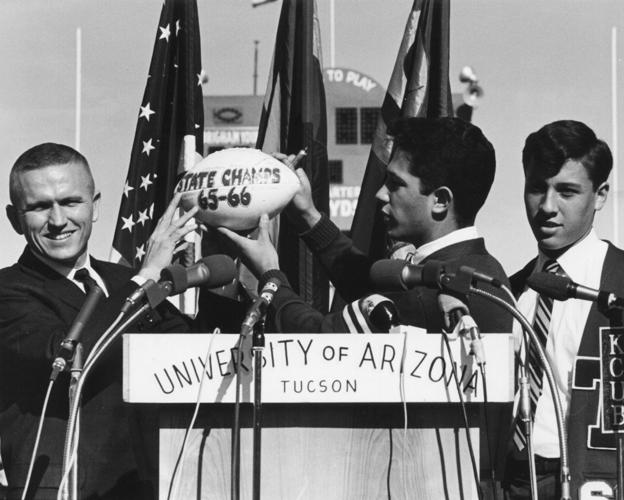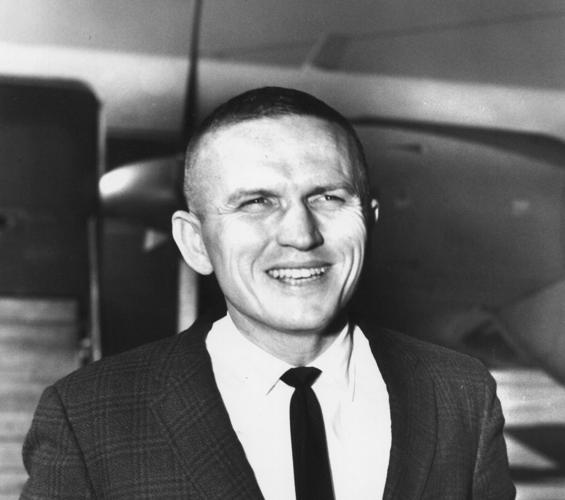Fifty-five years ago, on Christmas Eve of 1968, Tucson astronaut and hometown legend Frank Borman and his Apollo 8 crew maneuvered into lunar orbit.
As they circled the moon, they read from the Book of Genesis in a live telecast from the orbiter:
“In the beginning, God created the heaven and the earth. And the earth was without form, and void; and darkness was upon the face of the deep.”
Borman ended the broadcast with, “And from the crew of Apollo 8, we close with good night, good luck, a Merry Christmas, and God bless all of you — all of you on the good Earth.”
It was on the crew’s fourth of 10 orbits that astronaut William Anders snapped the iconic “Earthrise” photo showing a blue and white Earth rising above the gray lunar landscape.
“It’s arguably the most iconic photograph of the 20th century: the Earth rising above the Moon’s bleached and desolate horizon, a breathtaking jewel of color,” Smithsonian magazine has written.

Left to right: Frank Borman, commander, and his Apollo 8 crewmates William A. Anders and James A. Lovell, Jr., a few days before their Christmas 1968 journey to the moon.
Associated PressBorman later wrote about how the Earth looked from afar:
“We were the first humans to see the world in its majestic totality, an intensely emotional experience for each of us. We said nothing to each other, but I was sure our thoughts were identical — of our families on that spinning globe. And maybe we shared another thought I had, This must be what God sees.”
The mission commanded by Borman paved the way for the first moon landing the following year.
Borman, who grew up in Tucson, died this year, on Nov. 7, at the age of 95.

Frank Borman
- Mike Christy / for the Arizona Daily Star
Retired NASA astronaut Frank Borman speaks with children from Mission Manor Elementary School Wednesday, Feb. 17, 2010, in Tucson, Ariz. about his trips to space. Col. Borman served as commander of the Gemini 7 and Apollo 8 missions in the 1960s. (Mike Christy / for the Arizona Daily Star)

Frank Borman
- James S. Wood / Arizona Daily Star
This Lunar Sample was given to astronaut Frank Borman, who led the first team of American astronauts to leave Earth's orbit and circle the Moon on Apollo 8, by Astronaut and Senior NASA representative Mark Polansky, during Pima Air & Space Museum's 30th anniversary celebration, Monday May 8, 2006 in Tucson, Ariz. Photo by James S. Wood Arizona Daily Star

Frank Borman
- James S. Wood / Arizona Daily Star
Trevor Stramler, 4, shakes the hand of astronaut Frank Borman, who led the first team of American astornauts to leave Earth's orbit and circle the Moon on Apollo 8, while trevor's parents Edward Stramler, and Kerrie Stramler, look on during Pima Air & Space Museum's 30th anniversary celebration, Monday May 8, 2006 in Tucson, Ariz. Photo by James S. Wood Arizona Daily Star

Frank Borman
- Mike Christy / for the Arizona Daily Star
Retired NASA astronaut Frank Borman signs fifth-grader Derek Contreras' arm Wednesday, Feb. 17, 2010 in Tucson, Ariz. after speaking with students from Mission Manor Elementary School about his trips to space. Col. Borman served as commander of the Gemini 7 and Apollo 8 missions in the 1960s. (Mike Christy / for the Arizona Daily Star)

Frank Borman
- Jack Shaeffer
Astronaut Frank Borman is an old Tucson High Badger. He was a quarterback on the championship football team of 1946 and was made an honorary member of the championship Badger team of 1965 yesterday at Tucson ceremonies hailing his epic space flight. But up to yesterday Borman had never seen a live Badger. He was introduced to this badger by Hal Gras of the Arizona-Sonora Desert Museum staff. Photo taken Jan. 10, 1966.

Frank Borman
- Jack Shaeffer
Tucson astronaut Frank Borman and Frank Mendez hold Tucson High School's 1965 championship game football yesterday which the spaceman signed after being named an honorary team member. Mendez played linebacker for the THS grid squad. Mendez drew laughter from the University of Arizona stadium audience when he said Borman signed the ball "to encourage other THS graduates to attain the heights you have reached."

Frank Borman
- Harvey Georges
President Richard Nixon ushers Frank Borman to a White House microphone in Washington, on Jan. 30, 1969 after announcing that the moon-circling astronaut and his family will make an eight-nation goodwill tour of Western Europe. Wither them are the other two Apollo 8 astronauts are James Lovell, and William Anders, right. The Borman's will leave Sunday for visits to Great Britain, France, Belgium, The Netherlands, West Germany, Italy, Spain and Portugal. (AP Photo/ Harvey Georges )

Frank Borman
- ASSOCIATED PRESS
A December 1968 file photo picture shows the Apollo 8 crew, from left: commander Frank Borman, command modul pilot James A. Lovell, Jr., and lunar module pilot William A. Anders. Dec. 21, 2008 sees the 40th anniversary of the launch of the Apollo 8 mission bringing Mission Commander Frank Borman, Command Module Pilot James Lovell and Lunar Module Pilot William Anders as the first humans ever to another celestial body. The mission during which the Apollo 8 crew became the first humans to see the far side of the Moon, paved the way for later missions including Apollo 11 to land the first man on the Moon in 1969. (AP Photo/Stf, File)

Frank Borman
- Dale Fulkerson
Retired astronaut Col. Frank Borman poses on the wing of his 1944 vintage P-51 Mustang Sunday, Dec. 20, 1998, in his hanger at the Las Cruces International Airport in New Mexico. Borman, now 70, was one of three astronauts on the Apollo 8 mission that flew around the moon Dec. 21, 1968. Monday marks the 30th anniversary of the launch of that mission. (AP Photo/Dale Fulkerson)

Frank Borman
- Mike Christy / for the Arizona Daily Star
Retired NASA astronaut Frank Borman signs fifth-grader Angelita Muñoz's arm Wednesday, Feb. 17, 2010 in Tucson, Ariz. after speaking with students from Mission Manor Elementary School about his trips to space. (Mike Christy / for the Arizona Daily Star)
Tucson legends: Frank Borman
Frank Borman, well-known astronaut who went to the moon 50 years ago in Apollo 8, though he didn't get to land there, grew up in Tucson.
Frank Borman
- Mike Christy / for the Arizona Daily Star
Retired NASA astronaut Frank Borman speaks with children from Mission Manor Elementary School Wednesday, Feb. 17, 2010, in Tucson, Ariz. about his trips to space. Col. Borman served as commander of the Gemini 7 and Apollo 8 missions in the 1960s. (Mike Christy / for the Arizona Daily Star)
Frank Borman
- James S. Wood / Arizona Daily Star
This Lunar Sample was given to astronaut Frank Borman, who led the first team of American astronauts to leave Earth's orbit and circle the Moon on Apollo 8, by Astronaut and Senior NASA representative Mark Polansky, during Pima Air & Space Museum's 30th anniversary celebration, Monday May 8, 2006 in Tucson, Ariz. Photo by James S. Wood Arizona Daily Star
Frank Borman
- James S. Wood / Arizona Daily Star
Trevor Stramler, 4, shakes the hand of astronaut Frank Borman, who led the first team of American astornauts to leave Earth's orbit and circle the Moon on Apollo 8, while trevor's parents Edward Stramler, and Kerrie Stramler, look on during Pima Air & Space Museum's 30th anniversary celebration, Monday May 8, 2006 in Tucson, Ariz. Photo by James S. Wood Arizona Daily Star
Frank Borman
- Mike Christy / for the Arizona Daily Star
Retired NASA astronaut Frank Borman signs fifth-grader Derek Contreras' arm Wednesday, Feb. 17, 2010 in Tucson, Ariz. after speaking with students from Mission Manor Elementary School about his trips to space. Col. Borman served as commander of the Gemini 7 and Apollo 8 missions in the 1960s. (Mike Christy / for the Arizona Daily Star)
Frank Borman
- Jack Shaeffer
Astronaut Frank Borman is an old Tucson High Badger. He was a quarterback on the championship football team of 1946 and was made an honorary member of the championship Badger team of 1965 yesterday at Tucson ceremonies hailing his epic space flight. But up to yesterday Borman had never seen a live Badger. He was introduced to this badger by Hal Gras of the Arizona-Sonora Desert Museum staff. Photo taken Jan. 10, 1966.
Frank Borman
- Jack Shaeffer
Tucson astronaut Frank Borman and Frank Mendez hold Tucson High School's 1965 championship game football yesterday which the spaceman signed after being named an honorary team member. Mendez played linebacker for the THS grid squad. Mendez drew laughter from the University of Arizona stadium audience when he said Borman signed the ball "to encourage other THS graduates to attain the heights you have reached."
Frank Borman
- Harvey Georges
President Richard Nixon ushers Frank Borman to a White House microphone in Washington, on Jan. 30, 1969 after announcing that the moon-circling astronaut and his family will make an eight-nation goodwill tour of Western Europe. Wither them are the other two Apollo 8 astronauts are James Lovell, and William Anders, right. The Borman's will leave Sunday for visits to Great Britain, France, Belgium, The Netherlands, West Germany, Italy, Spain and Portugal. (AP Photo/ Harvey Georges )
Frank Borman
- ASSOCIATED PRESS
A December 1968 file photo picture shows the Apollo 8 crew, from left: commander Frank Borman, command modul pilot James A. Lovell, Jr., and lunar module pilot William A. Anders. Dec. 21, 2008 sees the 40th anniversary of the launch of the Apollo 8 mission bringing Mission Commander Frank Borman, Command Module Pilot James Lovell and Lunar Module Pilot William Anders as the first humans ever to another celestial body. The mission during which the Apollo 8 crew became the first humans to see the far side of the Moon, paved the way for later missions including Apollo 11 to land the first man on the Moon in 1969. (AP Photo/Stf, File)
Frank Borman
- Dale Fulkerson
Retired astronaut Col. Frank Borman poses on the wing of his 1944 vintage P-51 Mustang Sunday, Dec. 20, 1998, in his hanger at the Las Cruces International Airport in New Mexico. Borman, now 70, was one of three astronauts on the Apollo 8 mission that flew around the moon Dec. 21, 1968. Monday marks the 30th anniversary of the launch of that mission. (AP Photo/Dale Fulkerson)
Frank Borman
- Mike Christy / for the Arizona Daily Star
Retired NASA astronaut Frank Borman signs fifth-grader Angelita Muñoz's arm Wednesday, Feb. 17, 2010 in Tucson, Ariz. after speaking with students from Mission Manor Elementary School about his trips to space. (Mike Christy / for the Arizona Daily Star)
Become a #ThisIsTucson member! Your contribution helps our team bring you stories that keep you connected to the community. Become a member today.














